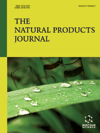- Home
- A-Z Publications
- Natural Products Journal, The
- Previous Issues
- Volume 11, Issue 2, 2021
Natural Products Journal, The - Volume 11, Issue 2, 2021
Volume 11, Issue 2, 2021
-
-
Antidiabetic Properties of Medicinal Mushrooms with Special Reference to Phellinus Species: A Review
More LessAuthors: Thekkuttuparambil A. Ajith and Kainoor K. JanardhananDiabetes remains the major public health challenge to the 21st century. It is strongly related to lifestyle changes. Most chronic complications of diabetes are macrovascular and microvascular diseases resulting from the existing hyperglycemic status. After the failure of first-line therapy, which is based on diet modifications and exercise, conventional treatment using antihyperglycemic agents with different mechanisms of Read More
-
-
-
Proposed Mechanism of Tecoma stans in Diabetes-Associated Complications
More LessAuthors: Amit Gupta and Tapan BehlTecoma stans (L.) Juss. ex Kunth has shown potent antidiabetic effect in the past; however, none of the studies have been carried out to explore its effect in diabetic complications including diabetic retinopathy and nephropathy. Thus, this review will aim to explore and propose multiple hypotheses regarding its mechanism of action in diabetic complications which includes reduction in oxidative stress, inflammation, angio Read More
-
-
-
Bamboo a Supplement to Human Health: A Comprehensive Review on its Ethnopharmacology, Phytochemistry, and Pharmacological Activity
More LessAuthors: Mansi Patel and Priti MehtaBamboo species belonging to the Poaceae family, Poaceae has overall about 1,500 species, and 87 genera worldwide, randomly distributed between humid tropical, sub-tropical and mildmoderate regions across the globe. The plant has superior value in traditional indigenous systems of China, Ayurveda, Siddha, and Unani for its enormous medicinal and nutritional purposes since 2500 years. It was the apparent beginning Read More
-
-
-
Recent Advances in Chemotherapeutic Implications of Deguelin: A Plant- Derived Retinoid
More LessAuthors: Manzoor A. Mir, Umar Mehraj and Bashir A. SheikhDeguelin, a plant retinoid has emerged to be a promising therapeutic agent in the treatment of different cancers. Recent studies demonstrate that deguelin has potential as an angiogenesis antagonist in malignant and endothelial cells by specifically targeting HGF-c-Met and VEGFVEGFR pathways. It is reported to have profound therapeutic effects in pancreatic cancer by inactivation of the hedgehog (Hh) signalling pathw Read More
-
-
-
Chemical Composition and Antimicrobial Activity of Essential Oil and Hydrosol Extract From Roots of Plumbago europaea and in-vitro Combinatory Antimicrobial Effect of Hydrosol Extract with Gentamicin and Amphotericin B
More LessAuthors: Faiza Kaddour, Nadia Aissaoui, Mohammed E. A. Dib, Okkacha Bensaid and Alain MuselliBackground: Infectious diseases are responsible for millions of deaths a year worldwide. Antibiotics, which have saved so many lives and improved life expectancy, may become ineffective due to a worrying increase in bacterial resistance. Some of the appropriate actions that could be initiated to address this problem are to develop and search for new antimicrobial substances from medicinal plants, and combine antibiotics with Read More
-
-
-
Anthraquinone Derivatives and its Antibacterial Properties from Paederia foetida Stems
More LessAuthors: Aryandi Ramadhan, Agustin K. Wardani, Bongani Sicelo Dlamini and Chi-I ChangBackground: Paederia foetida (Rubiaceae) locally known as Chinese fever vine is a prominent plant species in the east and south Asia. The extract of Paederia foetida Linn. has been used for the treatment of gastric infections or other digestive disorders in Chinese traditional medicine. Objective: The main aim of the study was to isolate bioactive constituents of P. foetida stem through a bio-guided assay, then evaluate t Read More
-
-
-
Aristolochia triangularis Cham. Stems and Leaves’ Essential Oils and their Antimicrobial and Antimycobacterial Effects
More LessBackground: Aristolochia triangularis Cham., popularly known as the "cipó-milhomens", "angelicó" and "ypê-mi", is applied for the treatment of wounds, skin diseases (6,7), digestive and circulatory system diseases as an antipyretic and for malaria fever also. Objective: In this work, we investigated the chemical composition, the antimicrobial and antimycobacterial activities of the Essential Oils (EOs) extracted from A. tri Read More
-
-
-
Characterization of Streptomyces sp. UK-201 from Lachhiwala Reserve Forest, a Biodiversity Hot Spot of the Himalayas
More LessAuthors: Nidhi Srivastava, Sanjay Gupta and Indira P. SarethyBackground: Multi-drug resistance among pathogens is emerging due to the slow pace of development of new antimicrobials by combinatorial chemistry. Natural products from microorganisms obtained from under-explored habitats can be lead molecules for such discoveries. In search of new antimicrobial compounds, Streptomyces isolate UK-201 exhibiting broad-spectrum antimicrobial and antifungal activity, obtained fr Read More
-
-
-
Production of Vincristine and Vinblastine by the Endophytic Fungus Botryosphaeria laricina Strain (CRS1) is Dependent on Stimulating Factors Present in Catharanthus roseus
More LessAims: To isolate vinca alkaloid producing endophytic fungi from Catharanthus roseus and the evaluation of the factors which enhance the vincristine production. Background: An endophytic fungus Botryosphaeria laricina (CRS1) isolated from Catharanthus roseus demonstrated vinca alkaloid production under certain conditions. Objective: To Understand the conditions under which the fungus was able to produce vincristine and Read More
-
-
-
Investigation of Nutritional Contents, Antioxidant and Immunostimulatory Activities of Aqueous Extract from Laguncularia racemosa Leaves
More LessBackground: One of the four most incident plant species in mangrove is the Laguncularia racemosa, widely used in popular medicine against inflammation and fever. Objective: Here, L. racemosa was investigated in relation to their phytochemical profile, antioxidant activity, cytotoxicity, antimicrobial and immunostimulatory effect. Methods: Aqueous extract was obtained from leaves of plant, its phytochemical profile was Read More
-
-
-
In Vitro Antioxidant and Anti-Convulsant Activity of Methanolic Extract of Sarasvata churna Using scPTZ and MES Models
More LessAuthors: Rahul Kaushik, Jainendra Jain and Avijit MazumderBackground: Sarasvata churna is an Ayurvedic formulation for treatment and management of epilepsy and other maniac disorders since thousands of years. Objective: This study aimed to evaluate the in vitro antioxidant potential, total phenolics and flavonoids content, acute-oral-toxicity and anticonvulsant activity of Sarasvata churna. Materials & Methods: In vitro antioxidant activity of methanolic extract of Sarasvata churna Read More
-
Volumes & issues
Most Read This Month
Article
content/journals/npj
Journal
10
5
false
en


